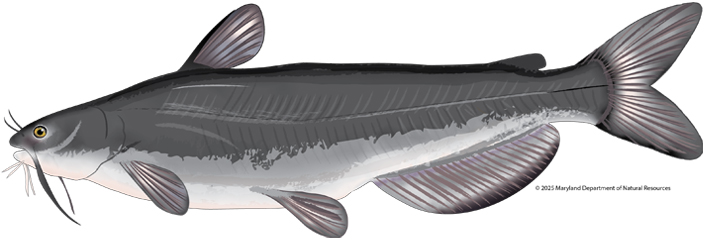| White Catfish |
 |
White Catfish |
| Ameiurus catus |
(A.K.A. - Mudcats, Cats)
|
Key Distinguishing Markings:
- White catfish are members of the bullhead catfish family, Ictaluridae.
- White catfish are the smallest of the large North American catfish species.
- The White catfish has white chin barbells, which distinguish it from other species. There are four pairs of barbels ("whiskers") around the mouth, two on the chin, one at the angle of the mouth, and one behind the nostril.
- White catfish lack scales and possess an adipose fin, as well as a single, often serrated spine in the dorsal and pectoral fins.
- White catfish are bluish-gray on their back and sides and white underneath. Their tail is moderately forked and they have a noticeably broad head, large mouth and stout body and are smaller in size than channel catfish.
View the White Catfish Gallery
|
Distribution:
- White catfish inhabit fresh and brackish water bodies along the Atlantic and Gulf coast states from New York to Florida, and are native to the Chesapeake Bay system.
- White catfish have been introduced into the mid-west and along portions of the west coast of the US.
|
Size:
- White catfish rarely exceed 6 pounds and 24 inches long. Average size is about 13 inches.
|
Habitat:
- White catfish are primarily a tidal water species that inhabit waters having a salinity of 5 parts per thousand, but also is found in freshwater lakes, ponds, rivers and streams.
- Habitats include: sluggish, mud-bottomed pools, open channels, and backwaters of small to large rivers.
|
Spawning:
- White catfish spawn in early summer when water temperatures reach 68-72oF in still or flowing waters near sand or gravel banks.
- Large, saucer-shaped nests are shaped by both parent fish by fanning the bottom with their tail. Several thousand eggs are deposited in the nest and are guarded until they hatch, which usually occurs within 6 to 7 days.
- Males may remain close to the fry until they stop schooling and disperse.
|
Fishing Tips:
- White catfish are very good to eat.
- Fresh baits such as worms, shrimp, chicken liver, processed bait and cut fish are popular methods for catching white catfish.
- Methods for fishing include bait casting and bottom fishing.
- For current recreational size and creel limits, see Maryland's updated regulation page.
|
Fun Fact:
- Catfish have numerous external taste buds, many of which are located on the barbels. Consequently, they can taste something by simply touching it with their barbels.
|
| Family: Ictaluridae (North American freshwater catfishes) |
| Order: Siluriformes (catfish) |
| Class: Actinopterygii (ray-finned fishes) |
For more information on white catfish and their management, please contact Mary Groves.
Illustration by Kevin Ensor,
Maryland Department of Natural Resources,
Fishing and Boating Services
|
